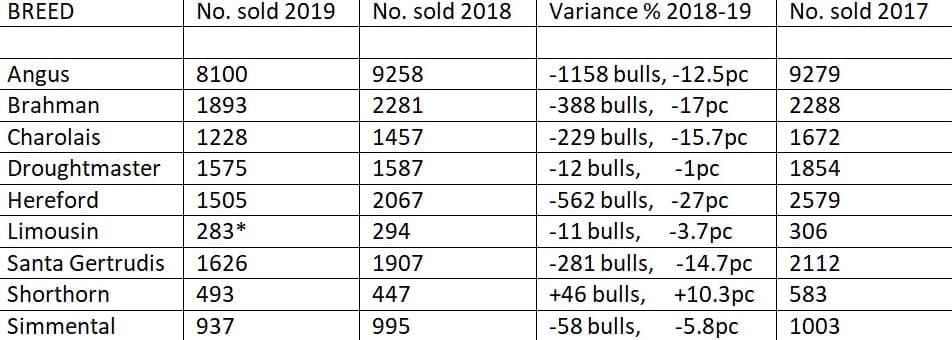A COMBINATION of fewer bulls being catalogued for sale by bull breeders, and lower sale clearance rates has driven a 13 percent decline in the number of bulls sold at auction this year across Australia.
Total bulls sold at auction this year for the nine breeds listed in Beef Central’s annual report was 17,640 head, down from 20,293 last year, and 4036 head or 19pc below the 21,676 bulls sold in 2017. That’s easily the largest two-year correction in bull numbers sold ever seen in the seedstock industry.
Results clearly show that while studmasters continued to reduce their catalogue offerings in 2019 in line with lower demand due to female liquidation due to drought, this was simply a continuation of a similar policy applied in some exposed breeds the year before.
As signs grew that the 2019 drought was not going to break, large numbers of young bulls were disposed of, either sent to the meatworks or into live export. Considerable numbers of young bulls found their way onto live export boats for the heavy export trade into markets like Vietnam, out of Port Alma and Townsville this year, as stud masters lowered their expectations over likely spring sale demand. Record high prices for lean grinding meat has also helped support the disposal of unwanted or surplus sale bulls this year.

* Incomplete data
As the table of 2019 results published above shows, while double digit declines in percentage terms for numbers sold were reasonably common among beef breeds this year, others showed much smaller reductions in numbers, or actually increased.
Shorthorns recorded a 10.3pc rise in numbers sold this year to 493 bulls, although that figure was coming off an unusually low base in 2018. Droughtmasters numbers were only 1pc below last year, at 1575 bulls, while Limousin numbers only reduced by 3.7pc.
Breeds recording the biggest downwards movement in bull volume turnover included Herefords, back 27pc, Brahmans back 17pc, Charolais back 15.7pc and Santa Gertrudis back 14.7pc. By and large, those breeds did not record such large reductions the year before, suggesting there might be some catch-up involved.
Clearance rates
While clearance rates were requested of all breeds approached for this report, only some were able to provide breed-wide results.
Clearance rates at auction should be viewed in the context of bull numbers offered, however, as some breeds clearly cut their numbers offered more severely than others this year.
Of those breeds reporting clearance rates in 2019, all were clearly impacted by drought. Herefords cleared 68pc of 2203 bulls offered; Shorthorns cleared 78pc of 631 bulls offered; Droughtmasters cleared 82pc of its offering of 1575 bulls (down from 84pc last year); while Santa Gertrudis breeders cleared 85pc of their offering.
The 2016 year is regarded as the ‘golidlocks’ year when everything went ‘just right’ for bull breeders, combining a better than average season in most areas with strong cattle prices and high international beef demand. And on top of that, herd recovery was still in progress after earlier drought, elevating demand even further.
Clearance rates for most reported breeds that year sat in the low to mid 90s.
Change in crossbreeding trends
In monitoring trends in bull demand, Beef Central asked Angus Australia’s Dr Peter Parnell whether the decline in F1 Wagyu breeding using Angus dams since the enormous spike seen two years ago was likely to be reflected in renewed Angus bull demand in coming years, as commercial Angus cattlemen returned to straightbreeding.
“We do expect that as herds rebuild after the season hopefully breaks in autumn 2020, that there will be a strong demand for Angus bulls (and females), including a swing back to Angus by some breeders who have dabbled in crossbreeding over the last year or so in search for promised market premiums,” he said.
“We believe that the long-term price advantage for quality Angus cattle, driven by strong export and domestic demand for Angus branded beef, will continue to reward breeders of straight-bred and high content Angus. Hence, despite the setback caused by the continuing widespread drought, Angus Australia remains positive about the medium-long term outlook for the breed and our members. This is likely to be reflected in the recovery of bull sale volumes sold and average prices over the next couple of years,” Dr Parnell said.
